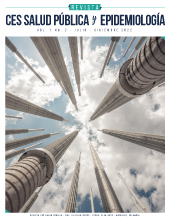Workplace Violence in the Healthcare Sector: When the Psychologist is the Victim. Case Report
DOI:
https://doi.org/10.21615/cesspe.6871Keywords:
workplace violence, stress disorder, traumatic, occupational health, mental health, psychologyAbstract
Introduction: violence in the workplace has become a global problem that crosses borders, work contexts and professional groups. In the health sector, it is a ubiquitous, persistent and under-reported problem. Case report: a 43-year-old liaison psychologist with 20 years of work experience, is threatened with death by the mother of a pediatric patient. He immediately presents nervousness, anxiety, insomnia and fear for his life. A diagnosis of acute stress disorder is made, the symptoms persist and a month later he continues with behavioral avoidance, re-experiencing of the trauma, negative mood, psychophysiological reactivity, dissociative symptoms and great dysfunction in daily life, which configures an anxiety disorder. posttraumatic stress. A month after the trauma, suicidal ideation and plans appeared, for which he was hospitalized for psychiatry. She is discharged with psychopharmaceuticals and outpatient psychotherapy, and incapacity for work. Revision: workplace violence for healthcare employees is a real and growing problem. There are multiple barriers that prevent making this situation visible. Workers and employers in the health sector need to identify this important occupational risk and understand that violence is not “part of the job”. Conclusion: violence in the workplace for those who work in the health sector is a common problem, which requires education, legislation and strategies to prevent it.
Downloads
References
Organización Internacional del Trabajo. Directrices Marco Para Afrontar La Violencia Laboral En El Sector Salud. (2002) Organización Internacional del Trabajo, Consejo internacional de Enfermeras, Organización Mundial de la Salud, Internacional de Servicios Públicos, & Programa Conjunto Sobre La Violencia Laboral En El Sector De La Salud. Ginebra. pp 1-38. Disponible en: https://www.ilo.org/wcmsp5/groups/public/---ed_dialogue/---sector/documents/publication/wcms_160911.pdf
Organización Mundial de la Salud. Informe mundial sobre la violencia y la salud: Resumen. Organización Panamericana de la Salud, para la Organización Mundial de la Salud; 2002. pp1-33. https://apps.who.int/iris/bitstream/handle/10665/43431/9275324220_spa.pdf;jsessionid=E5ECF8849B6D4D56A754D2C101A29CE8?sequence=1
WHO | Violence against health workers. (s. f.). WHO; World Health Organization Consultado el 20 de marzo de 2022. Disponible en: http://www.who.int/violence_injury_prevention/violence/workplace/en/
Ministerio de Sanidad. INFORME. Grupo de trabajo de agresiones a profesionales del Sistema Nacional de Salud. Comisión de recursos Humanos del SNS. (2014): Ministerio de Sanidad, Servicios Sociales e Igualdad. Gobierno de España. http://www.senado.es/web/expedientappendixblobservlet?legis=10&id1=136341&id2=1
Giraldo Valencia J, Delgado L, Coronado G, Bohórquez-Robayo,F, Bernal-Sánchez R, Cuadros-Ruiz JG. Encuesta de las agresiones en el servicio de urgencias de las clínicas y hospitales afiliados a la ACHC. 2015; 102:2-24.
Luna-García JE, Urrego-Mendoza Z, Gutiérrez-Robayo M, Martínez-Durán. Violencia en el trabajo del sector público de la salud: Una visión desde las personas trabajadoras. Bogotá, Colombia. 2011-2012. Revista de la Facultad de Medicina. 2015; 63(3): 407-417. http://dx.doi.org/10.15446/revfacmed.v63n3.51027
Castellano-Ramírez JC, Prieto EF, Ortiz FL, Suárez BC, Polo, LB, Aristizábal JC, Casadiego-Gutiérrez EE. Prevención y protección de agresiones y violencia contra los trabajadores de la salud. Ministerio de Trabajo de Colombia. 2019. Diseño Gráfico y Diagramación, Galenao J.S. pp 1-15. Disponible en: https://www.oceinfo.org.co/difusion/material-en-general/send/10-material-y-presentaciones/150-cartilla-prevencion-y-proteccion-de-agresiones-y-violencia-contra-los-trabajadores-de-la-salud
Echeburúa E, Amor PJ, Sarasua B, Zubizarreta I, Holgado-Tello FP, Muñoz JM. Escala de Gravedad de Síntomas Revisada (EGS-R) del Trastorno de Estrés Postraumático según el DSM-5: Propiedades psicométricas. Terapia psicológica. 2016; 34(2), 111-128. https://doi.org/10.4067/S0718-48082016000200004
American Psychiatric Association. Diagnostic and Statistical Manual of Mental Disorders. American Psychiatric Association Publishing. 2013; pp 991.
Riley MS, Kienle GS, Barber M, Kienle GS, Aronson JK, von Schoen-Angerer T, et al. CARE guidelines for case reports: explanation and elaboration document. J Clin Epidemiol. 2017; 89, 218-235.
Ferrinho P, Antunes AR, Biscaia A, Conceição C, Fronteira I, Craveiro I, Santos O. Workplace Violence in the Health Sector Portuguese Case Studies. Joint Program on Workplace Violence in the Health Sector. International Labor Office, World Health Organization, International Council of Nurses, public Services International. 2003; pp 1-55.
Guidelines for Preventing Workplace Violence for Healthcare and Social Service Workers. Occupational Safety and Health Administration. U.S. Department of Labor. United States of America. Consultado el 16 de marzo de 2022, de https://www.osha.gov/Publications/osha3148.pdf
Wyatt R, Anderson-Drevs K, Male L. Workplace Violence in Health Care: A Critical Issue with a Promising Solution. JAMA. 2016; 316(10), 1037-1038. https://doi.org/10.1001/jama.2016.10384
The Joint Commission. Sentinel Event Alert. Consultado el 20 de marzo de 2022. Disponible en: https://www.jointcommission.org/resources/patient-safety-topics/sentinel-event/
Behnam M, Tillotson RD, Davis SM, Hobbs GR. Violence in the Emergency Department: A National Survey of Emergency Medicine Residents and Attending Physicians. Journal of Emergency Medicine. 2011; 40(5), 565-579. https://doi.org/10.1016/j.jemermed.2009.11.007
Palácios M, Loureiro dos Santos M, Barros do Val, Medina MI, de Abreu M, Soares-Cardoso L, Braganca-Pereira B. Workplace Violence in the Health Sector Country Case Study – Brazil. Joint Programme on Workplace Violence in the Health Sector. International Labor Office, World Health Organization, International Council of Nurses, Public Services International. Geneve.2003.
Lenehan GP. The Aftermath of Workplace Violence: One Person’s Account. J Emerg Nurs. 2005; 31 (6): 564-566. doi.org/10.1016/j.jen.2005.09.012
Sayed S, Lacoviello B M, Charney DS. Risk Factors for the Development of Psychopathology Following Trauma. Current Psychiatry Reports. 2015; 17(8), 70. https://doi.org/10.1007/s11920-015-0612-y
Duan X, Ni X, Shi L, Zhang L, Ye Y, Mu H, et al. The impact of workplace violence on job satisfaction, job burnout, and turnover intention: The mediating role of social support. Health and Quality of Life Outcomes. 2019; 17(1): 93. https://doi.org/10.1186/s12955-019-1164-3
Jo I. Lee S, Sung G, Kim M, Lee S, Park J, Lee K. Relationship between burnout and PTSD symptoms in firefighters: The moderating effects of a sense of calling to firefighting. International Archives of Occupational and Environmental Health. 2018; 91(1): 117-123. https://doi.org/10.1007/s00420-017-1263-6
Gillespie GL, Bresler S, Gates DM, Succop P. Posttraumatic Stress Symptomatology among Emergency Department Workers following Workplace Aggression. Workplace Health & Safety. 2013; 61(6): 247-254. https://doi.org/10.1177/216507991306100603
Richter D, Berger K. Post-traumatic stress disorder following patient assaults among staff members of mental health hospitals: A prospective longitudinal study. BMC Psychiatry. 2006; 6 (15). https://doi.org/10.1186/1471-244X-6-15
Shalev A, Liberzon I, Marmar C. Post-Traumatic Stress Disorder. New England Journal of Medicine. 2017; 376(25): 459-2469. https://doi.org/10.1056/NEJMra1612499
Olashore AA, Akanni OO, Molebatsi, K, Ogunjumo JA. Post-traumatic stress disorder among the staff of a mental health hospital: Prevalence and risk factors. S Afr J Psychiatry. 2018; 24, 1222. https://doi.org/10.4102/sajpsychiatry.v24i0.1222
Shi L, Wang L, Jia X, Li Z, Mu H, Liu X, Peng B, Li A, Fan L. Prevalence and correlates of symptoms of post-traumatic stress disorder among Chinese healthcare workers exposed to physical violence: A cross-sectional study. BMJ Open. 2017; 7(7): e016810. https://doi.org/10.1136/bmjopen-2017-016810
Occupational Safety and Health Administration. Guidelines for Preventing Workplace Violence for Healthcare and Social Service Workers. OSHA. 2016; 3148-04R, 60.
Phillips JP. Workplace Violence against Health Care Workers in the United States. New England Journal of Medicine. 2016; 374(17): 1661-1669. https://doi.org/10.1056/NEJMra1501998
Raveel, A., & Schoenmakers, B. (2019). Interventions to prevent aggression against doctors: A systematic review. BMJ Open, 9(9), e028465. https://doi.org/10.1136/bmjopen-2018-028465
Solórzano-Martinez AJ. Managing Workplace Violence with Evidence-Based Interventions: A Literature Review. Journal of Psychosocial Nursing and Mental Health Services. 2016; 54(9), 31-36. https://doi.org/10.3928/02793695-20160817-05
Dillon BL. Workplace violence: Impact, causes, and prevention. Work. 2012; 42(1), 15-20. https://doi.org/10.3233/WOR-2012-1322
Chappell S. The American Organization of Nurse Executives and Emergency Nurses Association guiding Priniples on Mitigating Violence in the Workplace. JONA: 45, (7/8): 358-60.
Solórzano-Martinez AJ. Managing Workplace Violence with Evidence-Based Interventions: A Literature Review. Journal of Psychosocial Nursing and Mental Health Services. 2016; 54(9): 31-36. https://doi.org/10.3928/02793695-20160817-05
D’Ettorre G, Pellicani V, Mazzotta M, Vullo A. Preventing and managing workplace violence against healthcare workers in Emergency Departments. Acta Bio-Medica: Atenei Parmensis. 2018; 89(4-S): 28-36. https://doi.org/10.23750/abm.v89i4-S.7113
Downloads
Published
How to Cite
Issue
Section
License
Copyright (c) 2023 Revista CES Salud Pública y Epidemiología

This work is licensed under a Creative Commons Attribution-NonCommercial-ShareAlike 4.0 International License.
Derechos de reproducción (copyright)
Cada manuscrito se acompañará de una declaración en la que se especifique que los materiales son inéditos, que no han sido publicados anteriormente en formato impreso o electrónico y que no se presentarán a ningún otro medio antes de conocer la decisión de la revista. En todo caso, cualquier publicación anterior, sea en forma impresa o electrónica, deberá darse a conocer a la redacción por escrito.
Plagios, duplicaciones totales o parciales, traduccones del original a otro idioma son de responsabilidad exclusiva de los autores el envío.
Los autores adjuntarán una declaración firmada indicando que, si el manuscrito se acepta para su publicación, los derechos de reproducción son propiedad exclusiva de la Revista CES Salud Pública y Epidemiología.
Se solicita a los autores que proporcionen la información completa acerca de cualquier beca o subvención recibida de una entidad comercial u otro grupo con intereses privados, u otro organismo, para costear parcial o totalmente el trabajo en que se basa el artículo.
Los autores tienen la responsabilidad de obtener los permisos necesarios para reproducir cualquier material protegido por derechos de reproducción. El manuscrito se acompañará de la carta original que otorgue ese permiso y en ella debe especificarse con exactitud el número del cuadro o figura o el texto exacto que se citará y cómo se usará, así como la referencia bibliográfica completa.



